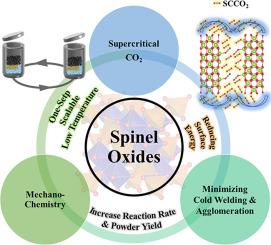高电化学性能尖晶石氧化物的超临界co2驱动机械化学合成
IF 14.3
1区 材料科学
Q1 MATERIALS SCIENCE, MULTIDISCIPLINARY
引用次数: 0
摘要
机械化学球磨是一种简单、高效的材料合成技术。冷焊对球磨工艺的反应速率和产粉率均有显著影响。本研究介绍了一种利用超临界二氧化碳(SCCO2)作为过程控制剂来缓解冷焊的新策略。研究人员阐明了SCCO2抑制冷焊的机制:SCCO2降低了表面能,钝化了球磨产生的新暴露表面上的悬垂键,从而防止了不必要的再形成。在此基础上,开发了一种开创性的scco2驱动球磨(SDBM)方法,可以在室温下在8小时内一步可扩展地生产100 g二元尖晶石氧化物。值得注意的是,粉末收率从13%(传统球磨)显着提高到98%。合成的氧化尖晶石具有粒径小、Mg迁移增强、氧空位丰富、电化学性能高(MgCo2O4为385 C/g)等特点。除MgCo2O4外,还采用SDBM工艺制备了多种二、三元尖晶石氧化物。这些结果突出了SDBM技术在制造创新材料方面的巨大优势和普遍性。本文章由计算机程序翻译,如有差异,请以英文原文为准。

Supercritical CO2-driven mechanochemical synthesis for spinel oxides with high electrochemical performance
Mechanochemical ball milling is a straightforward and efficient technology for material synthesis. However, cold welding significantly hampers both the reaction rate and the powder yield of the ball milling process. This study introduces a novel strategy to mitigate cold welding by utilizing supercritical carbon dioxide (SCCO2) as a process control agent. The mechanism by which SCCO2 inhibits cold welding was elucidated: SCCO2 reduces surface energy and passivates dangling bonds on the newly exposed surfaces generated by ball milling, thereby preventing undesired re-formation. Building on this approach, a groundbreaking SCCO2-driven ball milling (SDBM) method was developed, enabling the one-step, scalable production of 100 g of binary spinel oxide at room temperature within 8 h. Remarkably, the powder yield increases significantly from 13% (conventional ball milling) to 98%. The synthesized spinel oxide exhibits a small particle size, enhanced Mg migration, abundant oxygen vacancies, and high electrochemical performance (385 C/g for MgCo2O4). Beyond MgCo2O4, various binary and ternary spinel oxides were fabricated using SDBM technology. These results highlight the considerable benefits and the universality of SDBM technology in the fabrication of innovative materials.
求助全文
通过发布文献求助,成功后即可免费获取论文全文。
去求助
来源期刊

Journal of Materials Science & Technology
工程技术-材料科学:综合
CiteScore
20.00
自引率
11.00%
发文量
995
审稿时长
13 days
期刊介绍:
Journal of Materials Science & Technology strives to promote global collaboration in the field of materials science and technology. It primarily publishes original research papers, invited review articles, letters, research notes, and summaries of scientific achievements. The journal covers a wide range of materials science and technology topics, including metallic materials, inorganic nonmetallic materials, and composite materials.
 求助内容:
求助内容: 应助结果提醒方式:
应助结果提醒方式:


